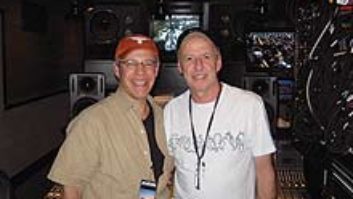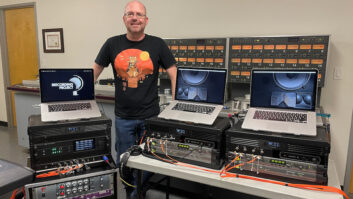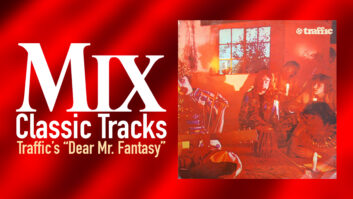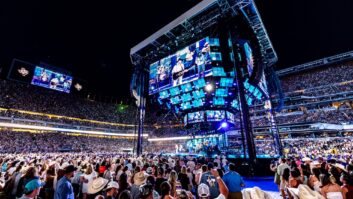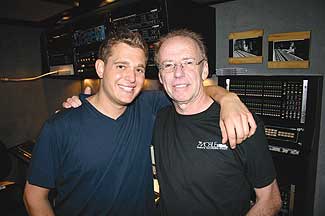
Inside Le Mobile are pop vocalist Michael Bublé (left) and studio owner/engineer Guy Charbonneau.
How do you survive in this type of economic climate, where the whole country’s in a downturn, and so is the remote business because of other factors, too?
That’s a good question. It’s hard to survive. The economic climate is a big part of the change, as well as the technology allowing different ways to record music. You now have an unlimited number of tracks, and a laptop does weigh much less than Studer 24-tracks.
You mean people bringing little rigs to record shows instead of using a truck like Le Mobile?
Yes, so we have to change the way we work, keeping in mind today’s budget constraints.
Le Mobile is well-known; people like it. Nothing sounds like the good old Neve [8058], and I love to combine the new and the old. I use Pro Tools for recording and fixing things, but we go through the Neve; we come back in Pro Tools using Apogee converters. I think the combination is great. I won’t go back to tape. Maybe the Studer 800 with Dolby SR at 15 ips for some special project.
But not every project needs to use Le Mobile so we’ve got other ways to help people. A couple of years ago, I built a portable fly pack system [Le Portable] that includes a Yamaha [DM2000] digital console, Grace [801] preamps, Pro Tools HD, Apogee converters. It fits in eight road cases and has everything someone would need to make a really good recording.
I am presently building a system in one box [Le Box]. I can rent that for $2,500 per week — 64 tracks of Nuendo. The band can record all their shows and do a quick balance mix, and upload onto the Internet. It’s a great box with a lot of hard drive [space], an AMD computer and it should fit many budgets. If recording backup is needed, I can add a MADI bridge, and then with a laptop you could have another Nuendo, Logic or even Pro Tools.
If the situation requires, I use a video truck control room, I engineer and take my full team with me. We are bringing knowledge to the project, and sometimes a few extra pieces of equipment from Le Mobile.
Three years ago, I also bought a beautiful building [in Carlsbad, north of San Diego], and I’m finishing a flexible control room. The idea is — it’s not a full studio, but it will be a place where a video editor and I can work on a project as a team. (That’s what I did back in the ’80s; that’s how I did the Montreal Jazz festival for 10 years.) I can use the room for preparing sessions for mixing or for 5.1 playback, or offer the room for a musician to write songs, or for doing archiving. I have these beautiful Studers well-maintained. This will give me another place and another way to work.
You’ve always been so quality-conscious. How do you change the mindset of musicians who will now accept audio that is less than perfect?
You cannot change that mindset. You can’t go back. Some artists will always want the best sound they can, and others will go for what they think is “good enough.” There’s nothing I can do to change those attitudes at this point, but a good mix and great music will always exist. So I have to be flexible and make everything we work on musically and sonically as good as we possibly can, no matter where and how it will be listened to.
Today, I’m not just selling Le Mobile, my fly pack or the box. I’m offering Le Mobile knowledge. I like to work on a full project from recording to delivering the master. You give me a budget and I will find the best way to achieve it. I’ve always said, if I need a pencil and eraser to do the project, great, that is what I’ll use. But I will never compromise. I will give my client and the artist what they expect from me.
You sound remarkably cheery.
[Laughs] I have faith in the long-term and in change, as well. You have to keep looking forward and keep learning.
Blair Jackson is the senior editor of Mix magazine.

